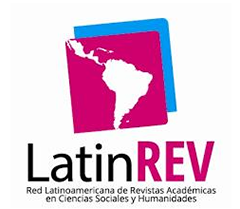Análisis bibliométrico de la relación entre innovación y liderazgo desde la perspectiva de la complejidad
DOI:
https://doi.org/10.20983/novarua.2025.30.4Palabras clave:
Bibliometría, Innovación, Liderazgo, ComplejidadResumen
La relación entre liderazgo e innovación abordada desde la teoría de la complejidad ha captado creciente interés académico, destacando la necesidad de comprender dinámicas organizacionales desde una óptica más integral. Este estudio analiza la evolución conceptual y temática de las investigaciones en este ámbito, identificando patrones clave para orientar futuras investigaciones. Mediante un análisis bibliométrico con el complemento Biblioshiny en RStudio, se analizaron 237 artículos publicados en Scopus entre 2004 y 2024. Los resultados evidencian un aumento sostenido en la producción científica, particularmente desde 2021, reflejando una consolidación del campo. Se concluye que investigaciones futuras deben priorizar metodologías cualitativas que profundicen en la dimensión humana y social del liderazgo, facilitando una comprensión más profunda de cómo se construyen capacidades adaptativas e innovadoras en contextos organizacionales complejos y dinámicos.
Citas
Afsar, B., y Umrani, W. A. (2020). Transformational leadership and innovative work behavior: The role of motivation to learn, task complexity and innovation climate. European Journal of Innovation Management, 23(3), 402-428. https://doi.org/10.1108/EJIM-12-2018-0257.
Agarwal, R., y Gupta, B. (2021). Innovation and Leadership: A Study of Organizations Based in the United Arab Emirates. Foundations of Management, 13(1), 73-84. https://doi.org/10.2478/fman-2021-0006.
Akter, R, Rathnayaka, S, y Ahmadi, Z. (2023). The effect of leadership and organisational culture on organisational innovation. International Journal of Services Technology and Management, 28(5), 360-388. http://doi.org/10.1504/IJSTM.2023.135084.
Ali, A., Jiang, X., Ali, A., y Qadeer, A. (2023). A moderated mediation model linking entrepreneurial leadership to green innovation: An upper echelons theory perspective. Creativity and Innovation Management, 32(1), 41-57. https://doi.org/10.1111/caim.12538.
Añazco, K., Valdivieso, R., Sánchez, O., y Guerrero, M. (2018). Los estilos de liderazgo y su efecto en la satisfacción laboral. INNOVA Research Journal, 3(10), 142-148. https://doi.org/10.33890/innova.v3.n10.2018.908.
Aria, M., y Cuccurullo, C. (2017). bibliometrix: An R-tool for comprehensive science mapping analysis. Journal of Informetrics, 11(4), 959-975. https://doi.org/10.1016/j.joi.2017.08.007.
Aristóteles (2015). Política (Traducido por C. García Gual y A. Pérez Jiménez). Alianza Editorial.
Aslam, H.D., Capusneanu, S., Javed, T., Rakos, I.S., y Barbu, C.M. (2024). The Mediating Role of Attitudes towards Performing Well between Ethical Leadership, Technological Innovation, and Innovative Performance. Administrative Sciences, 14(4), 62. https://doi.org/10.3390/admsci14040062.
Bass, B. M. (1985). Leadership and performance beyond expectations. Free Press.
Bass, B. M. (1990). From transactional to transformational leadership: Learning to share the vision. Organizational Dynamics, 18(3), 19-31. https://doi.org/10.1016/0090-2616(90)90061-S.
Burns, J. M. (1978). Leadership. Harper & Row.
Colovic, A. (2022). Leadership and business model innovation in late internationalizing SMEs. Long Range Planning, 51(1), 102083. https://doi.org/10.1016/j.lrp.2021.102083.
Costa, J., Pádua, M., y Moreira, A. C. (2023). Leadership Styles and Innovation Management: What Is the Role of Human Capital? Administrative Sciences, 13(2), 47. https://doi.org/10.3390/admsci13020047.
Dong, B. (2023). How Transformational Leadership Affects Firm Innovation Performance - A Perspective Based on Environmental Dynamism and Business Model Innovation. Journal of Chinese Human Resources Management, 14(2), 38-50. https://doi.org/10.47297/wspchrmWSP2040-800503.20231402.
Donthu, N., Kumar, S., Mukherjee, D., Pandey, N., y Lim, W. M. (2021). How to conduct a bibliometric analysis: An overview and guidelines. Journal of Business Research, 133, 285-296. https://doi.org/10.1016/j.jbusres.2021.04.070.
Flocco, N., Canterino, F., y Cagliano, R. (2021). Leading innovation through employees' participation: Plural leadership in employee-driven innovation practices. Leadership, 17(5), 499. https://doi.org/10.1177/1742715020987928.
Goleman, D. (2000). Leadership that gets results. Harvard Business Review.
He, S. C., Zhao, W. Y., Li, J. F., Liu, J. T., y Wei, Y. T. (2023). How environmental leadership shapes green innovation performance: A resource-based view. Heliyon, 9(7), e17993. https://doi.org/10.1016/j.heliyon.2023.e17993.
Judge, T. A., y Piccolo, R. F. (2004). Transformational and Transactional Leadership: A Meta-Analytic Test of Their Relative Validity. Journal of Applied Psychology, 89(5), 755-768. https://doi.org/10.1037/0021-9010.89.5.755.
León, B., Fernandez-Rio, J., Rivera-Pérez, S., y Iglesias, D. (2023). Cooperative learning, emotions, and academic performance in physical education: A serial multiple mediation model. Psicología Educativa, 29(1), 75-82. https://doi.org/10.5093/psed2023a2.
Lewin, K., Lippitt, R., y White, R. K. (1939). Patterns of aggressive behavior in experimentally created "social climates." The Journal of Social Psychology, 10, 269-299. https://doi.org/10.1080/00224545.1939.9713366.
Li, M., y Xiao, W. H. (2023). Research on the Effect of E-Leadership on Employee Innovation Behavior in the Context of Self and Relationship. Journal of Organizational and End User Computing, 35(1), 35. https://doi.org/10.4018/JOEUC.317090.
Likert, R. (1961). New patterns of management. McGraw-Hill.
Luhmann, N. (1995). Social systems. Stanford University Press.
Maak, T., Pless, N. M., y Voegtlin, C. (2016). Business statesman or shareholder advocate? CEO responsible leadership styles and the micro-foundations of political CSR. Journal of Management Studies, 53(3), 463-493. https://doi.org/10.1111/joms.12195.
Mahmood, M., Uddin, M. A., y Fan, L. (2019). The influence of transformational leadership on employees’ creative process engagement: A multi-level analysis. Management Decision, 57(3), 741-764. https://doi.org/10.1108/MD-07-2017-0707.
Morin, E. (2005). Introducción al pensamiento complejo. Gedisa.
Muenjohn, N., Mcmurray, A. J., Kim, J., y Afshari, L. (2024). Workplace innovation and work value ethics: The mediating role of leadership in Asian SMEs. Journal of Innovation & Knowledge, 9(3), 100547. https://doi.org/10.1016/j.jik.2024.100547.
Pasaribu, F., Bulan, T. R. N., Muzakir, y Pratama, K. (2021). Impact of strategic leadership and organizational innovation on strategic management: mediational role of it capability. Polish Journal of Management Studies, 24(2), 354-369. https://doi.org/10.17512/pjms.2021.24.2.22.
Platón (2013). La República (Traducido por M. Fernández-Galiano y J. M. Pabón). Alianza Editorial.
Pritchard, A. (1969). Statistical bibliography or bibliometrics? Journal of Documentation, 25(4), 348-349. https://doi.org/10.1108/eb026482.
Rasheed, M. A., Shahzad, K., y Nadeem, S. (2021). Transformational leadership and employee voice for product and process innovation in SMEs. Innovation & Management Review, 18(1), 69-89. http://doi.org/10.1108/INMR-01-2020-0007.
Rohlfer, S., Hassi, A., y Jebsen, S. (2022). Management Innovation and Middle Managers: The Role of Empowering Leadership, Voice, and Collectivist Orientation. Management and Organization Review, 18(1), 108-130. https://doi.org/10.1108/EJIM-03-2022-0101.
Uhl-Bien, M., y Arena, M. (2018). Leadership for organizational adaptability: A theoretical synthesis and integrative framework. The Leadership Quarterly, 29(1), 89-104. https://doi.org/10.1016/j.leaqua.2017.12.009.
Uhl-Bien, M., y Marion, R. (2020). Complexity leadership in bureaucratic forms of organizing: A meso model. The Leadership Quarterly, 31(2), 101289. https://doi.org/ 10.1016/j.leaqua.2009.04.007.
Uhl-Bien, M., Marion, R., y McKelvey, B. (2007). Complexity Leadership Theory: Shifting leadership from the industrial age to the knowledge era. The Leadership Quarterly, 18(4), 298-318. https://doi.org/10.1016/j.leaqua.2007.04.002.
Vicente-Ramos, W., y Durán-Carhuamaca, A. (2023). Bibiliometric Analysis of the Scientific Production of Deep Learning and Big Data. International Journal of Intelligent Systems and Applications in Engineering, 11(4), 355-362. https://hdl.handle.net/20.500.14559/156.
Vladic, N., Maletic, D., y Maletic, M. (2021). Determinants of Innovation Capability: An Exploratory Study of Inclusive Leadership and Work Engagement. Quality Innovation Prosperity-Kvalita Inovacia Prosperita, 25(2), 130-152. http://doi.org/10.12776/QIP.V25I2.1596.
Zupic, I., y Čater, T. (2014). Bibliometric Methods in Management and Organization. Organizational Research Methods, 18(3), 429-472. https://doi.org/10.1177/1094428114562629.
Descargas
Publicado
Número
Sección
Licencia
Derechos de autor 2025 José Andrés Gutiérrez Vázquez

Esta obra está bajo una licencia internacional Creative Commons Atribución-NoComercial-CompartirIgual 4.0.
Todos los contenidos de la edición electrónica de la revista se distribuyen bajo una licencia de uso y distribución “Creative Commons Reconocimiento-No Comercial-Compartir Igual 4.0 Internacional” (CC-BY-NC-SA). Puede consultar desde aquí la versión informativa de la licencia.
Aquellos autores/as que tengan publicaciones con esta revista, aceptan los términos siguientes: a) Los autores/as conservarán sus derechos de autor y garantizarán a la revista el derecho de primera publicación de su obra; b) Se permite y recomienda a los autores/as difundir su obra a través de Internet (p. ej.: en archivos telemáticos institucionales o en su página web), lo cual puede producir intercambios interesantes y aumentar las citas de la obra publicada. (Véase El efecto del acceso abierto).












